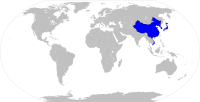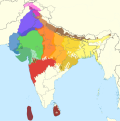Universal Languages
Many people have proposed "one language to unite the world". Esperanto came close. English is slowly stomping out many native tongues around the globe. Is the solution to back off and return to insurmountable diversity?
There are lessons to be learned from Esperanto. It had several things going for it. It was no one nation's language. It didn't belong to anybody but Esperantists. Its artificial nature is easy to learn, but ultimately was its downfall: it is hard to regard it as a heart-language for anyone. Its scope was also too broad. French and Spanish and even English are able to be united, but the little sprinkles of German, Polish, and Russian are too few and too unusual to make anyone happy. We can do better.
In fact, several people have already begun to do better. Interslavic has an ISO code. Interlingua does too. Folksprak is developing. Guosa is growing. Gaspirali's old project of Jalpi could be revived. In short, targeted Universal Languages are burgeoning. Rather than attempting to be one-world-language, or displace any native languages, these inventions are modest in design and practical in scope
- Unify a people. Every Universal Language unites a group of people, either because they are phylogenically related, or because a sprachbund binds their communities together. Even if your goal is global oneness, it makes sense to start with region oneness.
- Facilitate learning. "Basic English", "World English" and other parred-down languages are attempts to invite other in with less difficulty. An artificial language can be much, much easier to learn than a natural language. But like learning Latin before attempting Spanish, it lays the ground work for learning a used language.
- Clarify identity. If our region has a clearer identity, and our identity is clear within that, how much more we positioned are we? For example, do you really understand German unless you know where it fits within Germanic languages/people?
To meet these goal, 15 languages need to be designed, flushed out and then taught. Imagine if every English-speaker was bilingual! Throughout nearly all of human history, people who learned to read and write did so in a language not their own. Beyond normal, this was helpful. After a generation or two of this, a unique writing system for each Universal Language could be rolled out. Within a region, international and outward facing businesses and signage would be in the local Universal Language. Verbal arts would only need to be translated 14 times to reach 99% of all people. Anyone who travelled much would be fluent in several UL's. Regionalism would return to the world, and the very meaning of Globalism would change. The equal ultimacy of the One and Many would be heard and understood.
Dan'a'yo
The first and biggest UL is Dan'a'yo (単亜語/단아요). Uniting the largest slice of humanity, this Far East Asian language is unusual in that the peoples represented do not speak related languages. However, China-Japan-Korea-Vietname (CJKV) all have a shared history and cultural legacy that makes communication possible. 1.5 billion people speak Mandarin, Japanese, Korean, or older Vietnamese. This piece of the Sinosphere actually has Classical Chinese in common, even is some no longer write in Chinese characters at all. Despite being the most successful ideographic language ever, Chinese does not even unite the region, but nearly so. To that end, Dan'a'yo is written in both Chinese characters and the Korean alphabet.
Some important features that unite the region linguistically are
- Topic-Comment structure. This is actually more important than the SVO or SOV word-orders of the various languages.
- Classifiers. Like an elaborate gender system, numbers can only go on a select few words.
- Phonology. Nearly all the region is united in following the aspirated-vs-unaspirated distinction in stops.
- Texts. Confucius, Lao-Tzu, Mencius, Zhuangzi and other important texts were the backbone of all these societies until very recently.
Neo-Sanskrit
Through around 500 A.D. the Indo-European arrives on the Indian Subcontinent spoke Sanskrit. Most languages in the region passed through several Prakrits (intermediate stages), before devolving into Hindusatani, Punjabi, Kashmiri, Garwali, Rajasthani, Maithili, and many more. The native Dravidian languages had a large impact on phonology, but remained separate in most ways. Approximately 1.4 billion people are in this language group. It will be written in Kaithi, and it used be to the most widely used script of North India west of Bengal.
Some important features that unite the region linguistically are:
- Clipped Sanskrit. Most native words are shortened versions of the word in Sanskrit.
- Collapsing Phonology. While previously, four kinds of stops and five places of articulation for them (and nasals) was the rule, now different language have simplified this differently.
- Two genders. While very difficult to agree on what is which gender, all these languages have it, and even mark it on the verb at times.
- Postpositions. Even more important than case markers, free postpositions still dominate all these languages.
- Split Ergativity.
Interlingua
This already extant project serves the Romance languages of the world: French, Spanish, Italian, Portuguese, and others. Approximately 800 million people are in this zone. While we might have preferred for it to have kept two genders (as all the source languages do), it is still an excellent compromise across the region and a great Universal Language. Eventually, it will be the sole user of the Latin alphabet, and that without diacritics. There are four simple verb tenses, and three more compound tenses. It is SVO.
Folksprak
Folksprak is also an extant project, but it is apparently crippled by the same problem which merely plagues Interlingua: English. English's status as the de facto lingua franca of the world imposes many constraints upon a Germanic language that prevent group unity and decision making. De-platforming English means seeing it on equal footing with German, Dutch, Afrikaans, Swedish, Danish, Norwegian, and others. By immigration, this region includes America, Canada, Australia, New Zealand, much of South Africa, Belize, Guyana, and Suriname. This encompasses approximately 500 million people. After the introductory phase, Folksprak will be written in modernized runes.
A unique feature of Germanic language is that they are V2, which is subtly different from SVO. Other features include
- Front rounded vowels
- Short and long vowels
- Heavy use of discourse particles
Kintu
While Swahili has, in many ways, united northeastern Africa, a true pan-Bantu language is yet needed. Approximately 450 million people would be connected by this language, called Kintu. This includes the languages of Swahili, Shona, Zulu, Xhosa, Kinyarwanda, Kirundi, Lingala, Gikuyu, Nyanja, Tshiluba, and many more.
- Pre-nasalized stops
- Eight noun classes
- Seven vowels
- Five tenses and three aspects
- Agglutinative morphology
- Heavily prefixing
- Two tones (hence only one marked)
We propose a new script, Ditema tsa Dinoko, which has yet to be adopted.
Indo-Malay
Maritime Southeast Asia is a unique region. 380 million people.
- Clusivity
- Politeness marked on pronouns
- Reduplication
Guosa
Already extant project. Eventually using the N'Ko script, 340 million people in West Africa need a neutral means of communication.
Interslavic
Highly successful project. Eventually Cyrillic. 300 million, excluding South Slavic.
Middle Semitic
Work has begun. Written in Syriac from the start, which is already a middle ground between Hebrew and Arabic. 290 million people.
- Triconsonantal roots
- Pronominal suffixes
- Construct state
M.S.E.A.L.
Definitely a sprachbund, but fantastically diverse. Vietnamese, Thai, Cantonese, Khmer, Hmong, Bengali, etc. 250 million people.
Dravindian
230 million people
Zens
Iranian languages. 175 million. Written mostly in Arabic letters today, the future will see a return to the Avestan Alphabet.
- Tripartite. As a compromise position between the Nominative-Accusative and Split-Ergative languages.
Jalpi
Gaspirali invented a pan-Turkic language 200 year ago. With minor updates, it could serve well the 170 million people in this language family. Eventually, it will be written in the Armenian script.
- Vowel harmony
S.E.D.E.S.
The Horn of Africa has long been a sprachbund. 117 million people. Written in Ge'ez for now, eventually the script invented by Bakri Sapalo will be used.
Balkan
A small, diverse sprachbund exists in the Balkans. 60 million people. Written in the Greek alphabet.
Conclusion
Finno-Ugric, Mongolian, Celtic, Amerindian, Australian aborigines, the Caucasus, the Khoisan, two Baltic states, and many other regions are left out of this schema. They can certainly choose to be part of an UL group, but the ROI on a language area of under 50 million people is simply not worth the effort. Sorry.

















